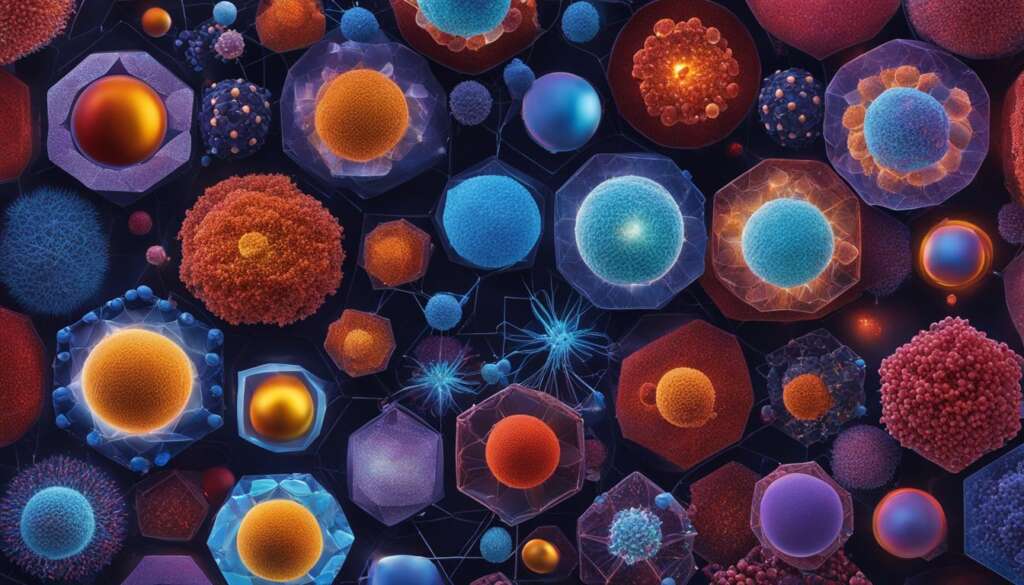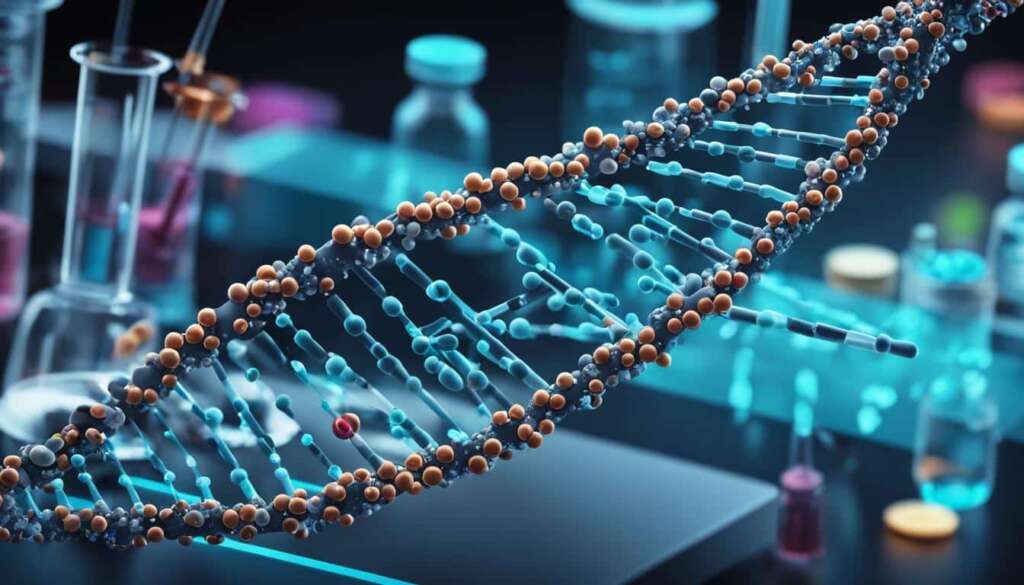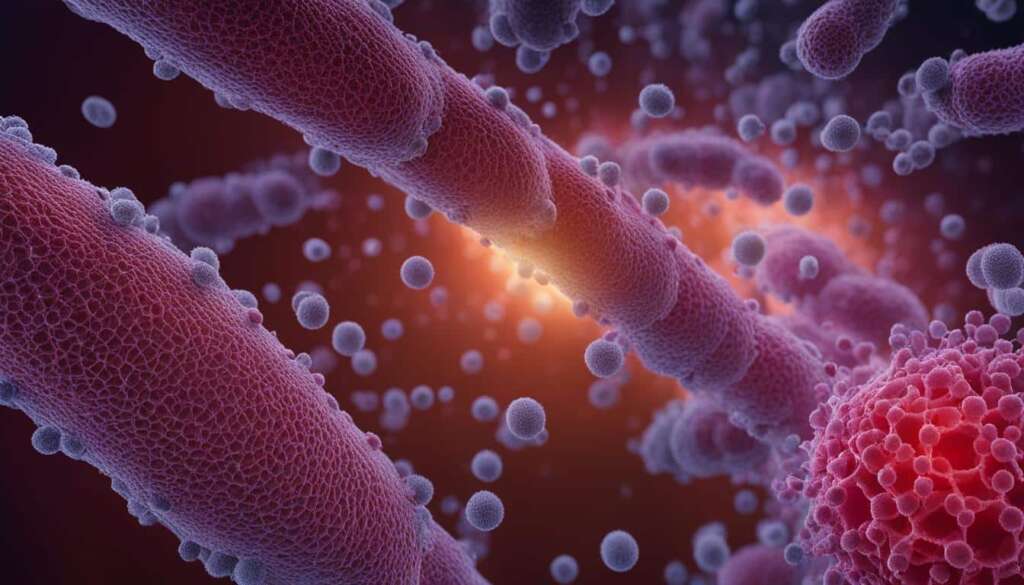Table of Contents
Nanotechnology is rapidly revolutionizing various industries and sectors, driving significant advancements in materials science, nanomedicine, and device engineering. This article delves into the future uses and impact of nanotechnology, highlighting its transformative potential for society and industry.
Key Takeaways
- Nanotechnology has a transformative potential across industries and sectors.
- Materials science benefits from nanotechnology’s ability to create stronger, lighter, and self-assembling materials.
- Nanomedicine utilizes nanoscale materials for targeted drug delivery, enhanced imaging, and tissue engineering.
- Device engineering benefits from nanotechnology’s development of nanoscale circuits, sensors, and self-healing structures.
- Nanotechnology holds immense potential for the future, with continued research driving further advancements and innovations.
What is Nanotechnology?
Nanotechnology is the understanding and control of matter at the nanoscale, between approximately 1 and 100 nanometers. At this scale, matter exhibits unique physical, chemical, and biological properties that differ from bulk materials and individual atoms or molecules. Nanotechnology enables the development of novel applications by harnessing these unique phenomena.
The nanoscale refers to the size range where individual atoms and molecules interact, creating new opportunities for scientific exploration and technological advancement. At such minuscule dimensions, materials behave differently, allowing scientists to manipulate and engineer substances to achieve desired properties and functionalities.
The extraordinary characteristics exhibited by nanoscale materials have sparked significant interest and exploration in the field of nanotechnology. It offers a promising avenue for innovative solutions and breakthrough advancements across various industries and scientific disciplines.
One of the defining features of nanotechnology is its ability to exploit and control unique phenomena that emerge at the nanoscale. These phenomena include quantum confinement, surface plasmon resonance, and the increased surface-to-volume ratio. They contribute to the creation of materials, structures, and devices with enhanced properties and capabilities.
Nanotechnology draws inspiration from nature, where many biological systems operate at the nanoscale. For example, the self-cleaning ability of lotus leaves or the extraordinary strength of spider silk can be attributed to nanoscale structures and interactions. By understanding and replicating these natural phenomena, scientists and engineers can develop innovative solutions for challenges faced in various industries.
Unique Phenomena at the Nanoscale
| Phenomenon | Description | Applications |
|---|---|---|
| Quantum Confinement | Electron and photon behavior in restricted dimensions | Semiconductor devices, quantum dots, solar cells |
| Surface Plasmon Resonance | Collective oscillation of electrons on metal surfaces | Sensors, imaging techniques, optoelectronics |
| Increased Surface-to-Volume Ratio | Large surface area compared to the volume of material | Catalysis, energy storage, drug delivery |
Nanotechnology’s understanding of the nanoscale and its ability to harness unique phenomena have paved the way for transformative advancements in various fields. From medicine and electronics to energy and environmental sustainability, nanotechnology is driving innovation, revolutionizing industries, and shaping our future.
Materials Science
In materials science, nanotechnology is revolutionizing the creation of stronger, lighter, and self-assembling materials through nanoscale engineering. By manipulating materials at the inter-atomic level, researchers can design and manufacture infrastructures with enhanced properties, paving the way for innovative advancements across industries such as construction and transportation.
Nanotechnology is enabling the development of materials with unparalleled strength-to-weight ratios, unlocking new possibilities for building lighter and more efficient structures. For example, carbon nanotubes are incredibly strong, yet lightweight, making them ideal for creating composite materials used in aerospace applications. These materials not only enhance fuel efficiency but also increase overall durability and safety.
Another significant area of progress is the development of self-assembling materials. These materials have the unique ability to autonomously arrange themselves into precise structures, driven by their molecular interactions. Self-assembling materials hold immense potential for manufacturing processes, as they can drastically simplify production and assembly. For instance, self-assembling nanoparticles can be used in 3D printing to create complex structures with precision and efficiency.
Nanotechnology is also enabling significant advancements in the field of 3D printing. By utilizing nanoscale engineering techniques, researchers can enhance the performance of printed materials, making them stronger, more durable, and even conductive. This opens up new possibilities for manufacturing custom-made products, such as prosthetics and wearable sensors, tailored to individual needs and specifications.
By harnessing nanoscale engineering, the materials science field is pushing boundaries and introducing new materials with remarkable properties, propelling innovation and shaping the future of various industries.
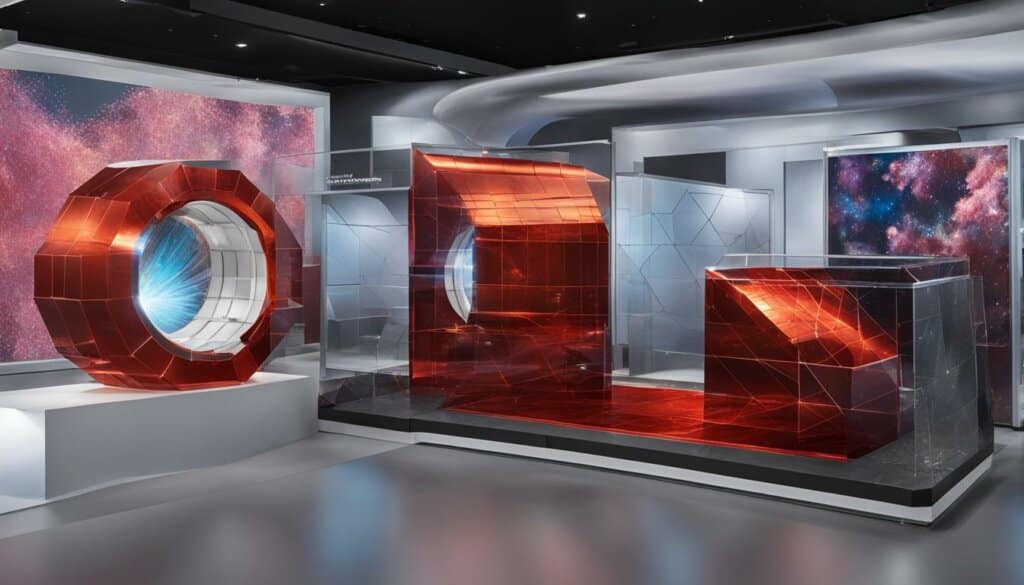
Advantages of Nanoscale Engineering in Materials Science:
| Advantages | Description |
|---|---|
| Enhanced Strength | Nanoscale engineering allows for the creation of materials with exceptional strength, capable of withstanding extreme conditions. These materials can be used in high-stress applications, providing increased safety and reliability. |
| Reduced Weight | The use of nanotechnology in materials science enables the development of lightweight materials without compromising strength. This is particularly beneficial in industries such as aerospace, automotive, and sports, where weight reduction enhances performance and efficiency. |
| Self-Assembly | Self-assembling materials simplify manufacturing processes by autonomously arranging themselves into precise structures. This offers potential cost and time savings in various industries, as well as opportunities for creating complex and intricate designs. |
| Customizability | Nanoscale engineering allows for materials to be tailored to specific requirements, enabling customization in various applications. This opens up possibilities for personalized medicine, prosthetics, and other specialized products. |
Nanomedicine
Nanomedicine utilizes nanoscale materials to diagnose and treat diseases, offering significant advancements in medical science. By leveraging the unique properties of nanoparticles, nanomedicine enables targeted drug delivery, enhanced imaging, and cutting-edge tissue engineering techniques.
One of the key applications of nanomedicine is in nanoscale drug delivery. Nanoparticles can be engineered to carry therapeutic compounds directly to the affected cells or tissues, improving treatment efficacy while minimizing side effects in comparison to traditional drug delivery methods. This targeted approach allows for more precise and effective treatments, revolutionizing patient care across various medical disciplines.
Nanotechnology has also revolutionized imaging and diagnostics. Advanced imaging techniques, such as quantum dots and superparamagnetic nanoparticles, offer enhanced contrast and resolution, enabling early and accurate disease detection. These improved imaging modalities play a crucial role in the diagnosis and monitoring of diseases, paving the way for more effective treatment strategies.
Tissue engineering is another area where nanotechnology has made significant contributions. Through the precise manipulation of nanoscale materials, researchers can create scaffolds that mimic the extracellular matrix, providing a framework for the growth and regeneration of tissues and organs. This breakthrough technology holds immense potential for organ transplantation, regenerative medicine, and the development of bionic organs.
“Nanomedicine holds the promise of improving disease diagnosis and treatment through targeted drug delivery, enhanced imaging, and advanced tissue engineering techniques.” – Dr. James Thompson, Medical Researcher
Advancements in Gene Sequencing and Drug Delivery Systems
The field of nanomedicine is also driving significant advancements in gene sequencing and drug delivery systems. Nanoparticles can be used as delivery vehicles for genetic material, improving the efficiency and effectiveness of gene therapy. Furthermore, nanotechnology plays a crucial role in the development of novel drug delivery systems, such as nanocarriers and nanogels, enhancing drug stability, bioavailability, and targeted delivery.
In summary, nanomedicine has transformed the landscape of healthcare by harnessing the power of nanoscale materials. From targeted drug delivery to enhanced imaging and diagnostics, and the development of functional tissues and organs, nanotechnology continues to push the boundaries of medical science, offering new hope for improved patient outcomes.
Device Engineering
In the field of device engineering, nanotechnology is revolutionizing the development of nanoscale circuits, nanosensors, and self-healing structures.
Nanoscale engineering techniques allow for the creation of highly efficient and miniaturized electronic components, paving the way for advancements in wearable technology, infrastructure monitoring, and energy efficiency.
Nanotechnology enables the production of nanoscale circuits that are capable of performing intricate tasks with precision and speed, leading to the creation of innovative electronic devices.
Furthermore, the integration of nanosensors in various devices opens up possibilities for enhanced sensing capabilities, enabling real-time monitoring and data collection in fields such as healthcare and environmental monitoring.
One of the remarkable applications of nanotechnology in device engineering is the development of self-healing structures. These structures have the ability to repair and regenerate themselves when damaged, prolonging their lifespan and reducing maintenance costs.
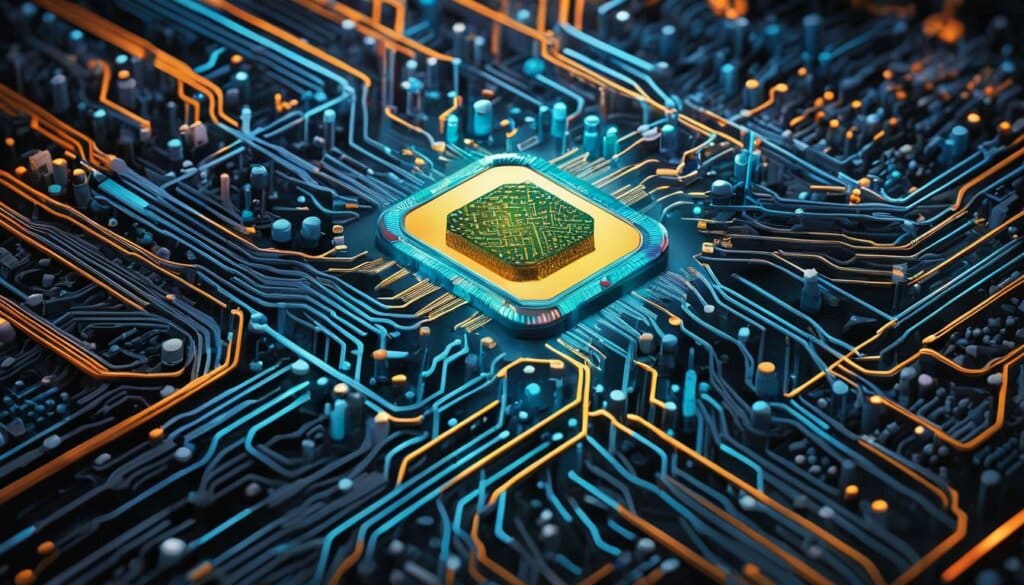
With nanotechnology, self-healing materials can detect and repair small-scale damage, preventing further degradation and preserving the integrity of the structure.
In summary, nanotechnology has opened up immense possibilities in the field of device engineering, with nanoscale circuits, nanosensors, and self-healing structures leading the way towards the development of more efficient, compact, and resilient electronic devices.
Future Applications in Industries
Nanotechnology has the potential to revolutionize a wide range of industries and verticals, propelling us into a future where unimaginable advancements become reality. Let’s explore the various sectors that will benefit from nanotechnology and the transformative impact it will have.
Electronics
Nanotechnology is paving the way for smaller, faster, and more efficient electronic devices. The ability to manipulate materials at the nanoscale enables the development of nanoelectronics, bringing forth innovations such as flexible displays, ultra-high-density memory, and nanosensors for enhanced functionality and connectivity.
Healthcare
The future of nanotechnology in healthcare holds immense promise. Nanomaterials and nanodevices can revolutionize drug delivery, allowing targeted therapies and reducing side effects. Additionally, nanotechnology enables advanced imaging and diagnostics, tissue engineering, and the creation of personalized medicine through precise drug targeting and gene therapy.
Energy
With the urgent need for sustainable energy solutions, nanotechnology offers a range of possibilities. Nanostructured materials can enhance energy storage and conversion efficiency, making renewable energy sources more viable. Nanotechnology can also improve the efficiency of energy transmission and distribution systems, leading to a greener and more sustainable future.
Environmental Sustainability
Nanotechnology has the potential to address environmental challenges and promote sustainability in various ways. For instance, nanomaterials can be used to create highly efficient catalysts for pollution control and water purification systems. Furthermore, nanotechnology can enable the development of sustainable and lightweight materials for construction and transportation, reducing environmental impact.
Agriculture and Food Industry
Nanotechnology holds promise in improving agricultural practices and enhancing food production. Nanosensors can monitor soil conditions, optimizing nutrient delivery and reducing water usage. Nanomaterials can also be employed for controlled-release fertilizers, crop protection, and food packaging to extend shelf life and prevent spoilage.
The future of nanotechnology is not limited to these sectors alone. As research and development continue, we can anticipate breakthroughs in automotive technology, construction and infrastructure, aerospace, and many other industries. The transformative potential of nanotechnology is vast and holds immense possibilities for a better future.
In Summary
“Nanotechnology’s future applications in industries are set to reshape our world by delivering innovations that were previously unimaginable. From electronics and healthcare to energy and agriculture, the potential of nanotechnology is boundless. As advancements continue, our industries will witness unprecedented growth and positive transformations, fueling progress on a global scale.”
Environmental and Societal Implications
While nanotechnology offers significant benefits, it is crucial to consider its potential environmental and societal implications. The production and disposal of nanomaterials can have an impact on the environment, posing challenges that need to be addressed. Ethical and regulatory questions regarding safety and privacy also arise with the widespread use of nanotechnology.
Nanotechnology has the potential to play a pivotal role in addressing global challenges, such as climate change. By enabling more efficient energy generation and storage, nanotechnology can contribute to mitigating the environmental impact of various industries. Additionally, nanotechnology can support sustainable agriculture practices, reducing the ecological footprint of food production.
“Nanotechnology has far-reaching implications for our society, and it is crucial to strike a balance between harnessing its potential and mitigating its potential risks.” – Dr. Emma Wilson, Environmental Scientist
Regulatory frameworks and responsible practices need to be established to ensure the safe and sustainable use of nanotechnology. Close collaboration between scientists, policymakers, and stakeholders is essential in developing guidelines and standards that address the environmental impact of nanotechnology while capitalizing on its transformative potential.
In summary, while nanotechnology opens up exciting possibilities, it is essential to approach its development with caution and responsibility. By carefully considering the environmental and societal implications, we can harness the power of nanotechnology to bring about positive change while safeguarding the well-being of our planet and communities.
Nanotechnology and Climate Change
One area where nanotechnology can make a significant difference is in tackling climate change. Climate change is a pressing global challenge that requires innovative solutions to reduce greenhouse gas emissions and promote sustainable practices.
Nanotechnology offers unique opportunities for addressing climate change by enabling the development of more efficient energy systems. Nanomaterials can be used to improve the performance of solar cells and enhance energy storage technologies, resulting in cleaner and more sustainable energy generation.
Furthermore, nanotechnology can play a crucial role in pollution control and environmental remediation. Nanoscale materials can be designed to capture and remove pollutants from air and water, helping to mitigate the impact of industries on the environment.
By leveraging the power of nanotechnology, we can pave the way towards a more sustainable and resilient future, combating climate change and preserving our planet for future generations.

Future Innovations and Trends
The field of nanotechnology is continuously evolving, with ongoing research and development driving future innovations. Exciting trends are emerging that are set to shape the future of nanotechnology across various sectors. Let’s explore some of the key areas:
1. Nanotechnology in Healthcare
The integration of nanotechnology with healthcare is set to revolutionize the medical industry. By combining nanoscale materials with artificial intelligence and brain-machine interfaces, advanced healthcare solutions are being developed. These innovations aim to enhance diagnostics, improve drug delivery systems, and enable personalized medicine. The use of nanotechnology in healthcare holds great promise in improving patient outcomes and transforming the way we approach disease management.
2. Advancements in Nanomaterials
Nanomaterials are at the forefront of nanotechnology advancements. With their unique properties at the nanoscale, these materials are paving the way for groundbreaking applications. From stronger and lighter materials for construction and transportation to self-healing structures, nanomaterials are driving innovation across various industries. The table below highlights some of the key advancements in nanomaterials:
| Advancements | Applications |
|---|---|
| Carbon nanotubes | High-performance composites, electronics |
| Nanocatalysts | Energy production, pollution control |
| Graphene | Electronics, energy storage, flexible displays |
| Quantum dots | LED displays, solar cells, medical imaging |
3. Nanorobotics and 3D Bioprinting
Nanorobotics and 3D bioprinting technologies are unlocking new possibilities in personalized medicine and tissue engineering. Nanorobots, operating at the nanoscale, can be used for targeted drug delivery and precise surgical procedures. 3D bioprinters, equipped with nanoscale resolution, enable the production of complex tissues and organs. These advancements have the potential to revolutionize healthcare by offering tailored treatments and organ replacements.
“The convergence of nanotechnology with healthcare holds the key to personalized medicine and transformative healthcare solutions.” – Dr. Sarah Thompson, Nanotechnology Expert
As nanotechnology continues to advance, these trends offer promising glimpses into the future possibilities of this field. From healthcare to materials science, nanotechnology is set to impact numerous industries, driving innovation and improving lives.
Nanotechnology in the Global Context
Nanotechnology is a global endeavor, with significant research, development, and investment taking place around the world. Various countries and organizations have launched initiatives to promote and advance nanotechnology research and applications. The global perspective on nanotechnology acknowledges its potential to drive economic growth, improve quality of life, and address global challenges.
“Nanotechnology holds immense promise for diverse fields, from healthcare to energy and beyond. Its global impact is undeniable, with nations investing heavily in research and development. The transformative potential of nanotechnology is recognized worldwide, fueling collaborations, knowledge sharing, and initiatives for international cooperation. Together, we strive to unlock the full potential of this groundbreaking science.” – Dr. Lisa Thompson, Nanotechnology Researcher
International perspectives on nanotechnology reflect the understanding that global collaboration is crucial for maximizing the benefits of this rapidly evolving field. Countries such as the United States, China, Japan, and Germany have made substantial investments in nanotechnology research and development, establishing themselves as leaders in the field. These nations recognize nanotechnology as a strategic priority and are actively promoting cross-disciplinary research and innovation.
In addition to country-specific initiatives, there are various global nanotechnology initiatives aimed at fostering collaboration and knowledge exchange. For example, the International Organization for Standardization (ISO) has developed standards for nanotechnology to ensure compatibility and safety across borders. The Global Nanotechnology Network (GNN) serves as a platform for sharing information and best practices among researchers, companies, and policymakers from different countries.
Investment in Nanotechnology Research
Investment in nanotechnology research is crucial for driving innovation and technological advancements. Governments, private sector companies, and international organizations are allocating significant resources to fund research projects and promote the commercialization of nanotechnology-based products. These investments aim to capitalize on the immense potential of nanotechnology and its ability to revolutionize multiple industries.
| Country/Organization | Investment in Nanotechnology Research |
|---|---|
| United States | Over $1.5 billion annually |
| China | More than $1 billion annually |
| European Union | €1.3 billion through the Horizon 2020 program |
| Japan | ¥20 billion annually |
These investments not only drive scientific discoveries but also stimulate economic growth by creating new job opportunities and fostering innovation ecosystems. By supporting nanotechnology research and development, countries and organizations position themselves at the forefront of technological advancements and gain a competitive edge in the global market.
The global nanotechnology landscape highlights the interconnectedness of scientific progress and international collaboration. Nanotechnology research and investment are shaping the future, with the potential to revolutionize industries and address pressing global challenges. The collective efforts of scientists, policymakers, and industry leaders from around the world contribute to a shared vision of harnessing the power of nanotechnology for the benefit of humanity.
Conclusion
Nanotechnology holds immense potential for the future, with its applications impacting various industries and sectors. The transformative potential of nanotechnology is evident in materials science, where researchers are creating stronger and lighter materials through nanoscale engineering. In nanomedicine, nanotechnology enables targeted drug delivery, enhanced imaging, and tissue engineering, revolutionizing the diagnosis and treatment of diseases. Moreover, nanotechnology is driving advancements in device engineering, paving the way for nanoscale circuits, sensors, and self-healing structures.
The impact of nanotechnology goes beyond these specific fields, with its applications expanding to various industries and vertics. From electronics and healthcare to energy and agriculture, nanotechnology is set to revolutionize these sectors. However, as with any emerging technology, there are also environmental and societal implications to consider. The responsible development and usage of nanotechnology require careful evaluation of its safety, privacy, and environmental impact.
Despite the challenges, nanotechnology continues to advance rapidly, with ongoing research and development fueling innovations. As we look to the future, the possibilities for nanotechnology are limitless. With further investments and collaborations, we can expect even more groundbreaking discoveries and applications that will shape the world we live in. Nanotechnology truly has the power to transform society, fuel economic growth, and address global challenges, making it a key driver for the future.
FAQ
What is nanotechnology?
Nanotechnology is the understanding and control of matter at the nanoscale, between approximately 1 and 100 nanometers. At this scale, matter exhibits unique physical, chemical, and biological properties that differ from bulk materials and individual atoms or molecules. Nanotechnology enables the development of novel applications by harnessing these unique phenomena.
How is nanotechnology used in materials science?
In materials science, nanotechnology is being used to create stronger, lighter, and self-assembling materials through nanoscale engineering. By manipulating materials at the inter-atomic level, researchers can design and manufacture infrastructures with enhanced properties, revolutionizing industries such as construction and transportation.
In what ways is nanotechnology advancing healthcare?
Nanotechnology, specifically nanomedicine, involves the use of nanoscale materials for diagnosing and treating diseases. Nanoparticles can be used for targeted drug delivery, enabling more effective treatments with reduced side effects. Nanotechnologies have also significantly improved imaging and diagnostic tools, tissue engineering, and the development of bionic organs.
How does nanotechnology impact device engineering?
Nanotechnology is driving the development of nanoscale circuits, sensors, and self-healing structures in device engineering. Nanoscale engineering techniques are used to create highly efficient and miniaturized electronic components, enabling advancements in wearable technology, infrastructure monitoring, and energy efficiency.
What industries can benefit from nanotechnology?
Nanotechnology has applications in various industries and verticals, including electronics, healthcare, energy, environmental sustainability, agriculture, and the food industry. It can revolutionize sectors such as automotive, construction, electronics, healthcare, and environmental protection.
What are the environmental and societal implications of nanotechnology?
While nanotechnology offers significant benefits, there are also environmental and societal implications to consider. The production and disposal of nanomaterials may have potential impacts on the environment. Nanotechnology also raises ethical and regulatory questions regarding safety and privacy.
What future innovations and trends can we expect in nanotechnology?
The field of nanotechnology is continuously evolving, with ongoing research and development driving future innovations. Emerging trends include the convergence of nanotechnology with other disciplines, such as artificial intelligence and brain-machine interfaces, to create advanced healthcare solutions. Additionally, advancements in nanomaterials, nanorobotics, and 3D bioprinting hold great promise for personalized medicine and tissue engineering.
How is nanotechnology approached globally?
Nanotechnology is a global endeavor, with significant research, development, and investment taking place around the world. Various countries and organizations have launched initiatives to promote and advance nanotechnology research and applications. The global perspective on nanotechnology acknowledges its potential to drive economic growth, improve quality of life, and address global challenges.
What is the future potential of nanotechnology?
Nanotechnology holds immense potential for the future, with its applications impacting various industries and sectors. From materials science and nanomedicine to device engineering and beyond, nanotechnology has the power to transform society and industry. As research and development in nanotechnology continue, we can expect further advancements and innovations that will shape the future of our world.

